How to Get Rid of Dog Urine Smell Using Vinegar
 If you have a pet, whether being a dog or cat, there's a very good chance you've dealt with at least a few piddle accidents in your home. We love our pets, but sadly their urine can gradually ruin your floors, raise your stress levels, and harm your health when it is frequently released into your home. We all know that when that smell is put in place, it's hard to get out, and can entice pets to want to repeatedly go in the same spot. Over time, you may not even realize that your beloved pets have now created an ammonia filled environment that you and your family are constantly breathing in.
If you have a pet, whether being a dog or cat, there's a very good chance you've dealt with at least a few piddle accidents in your home. We love our pets, but sadly their urine can gradually ruin your floors, raise your stress levels, and harm your health when it is frequently released into your home. We all know that when that smell is put in place, it's hard to get out, and can entice pets to want to repeatedly go in the same spot. Over time, you may not even realize that your beloved pets have now created an ammonia filled environment that you and your family are constantly breathing in.
Can simply vinegar and baking soda be the answer?
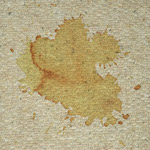 What's in Pet Urine?
What's in Pet Urine?
Pet urine is a combination of ammonia, bacteria, hormones, nitrogen and uric acid. It's the uric acid that creates a lingering smell even after you've cleaned up after your dog's or cat's tinkle area. It can be especially potent when the air is humid, a common occurrence in the town of Asheville.
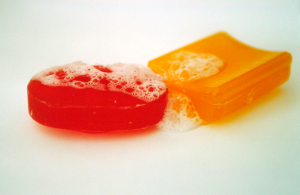 Why regular soap doesn't do the job
Why regular soap doesn't do the job
First let me explain that most of the germs and muck you find on your floor, whether urine or something else, typically cannot be dissolved in H20. That is why most of the time, a stain will not be removed by just using water alone. It's like trying to mix oil and water, they just oppose each other.
What soap does is form a bridge that connects the soiled matter to the water so that they can be picked up (with a wet paper towel or cloth) and removed from your floor. Soap is actually made up of fatty acids (derived from oils or fats) and a base (similar to salt), which means it has both the attributes of being repelled by water (known as hydrophobic) as well as being absorbed in water (known as hydrophilic). This allows the unwanted particles to adhere to a wet surface and be separated from the floor. So essentially soap is not making the urine disappear when you scrub over it, but simply allowing you to transfer it from one place to another (like into the garbage or washed down a drain).
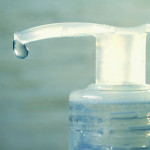 There are of course antibacterial soaps that are made from soap with antibiotics added. This empowers the soap to be able to kill the bacteria that lies in the urine when you pick it up. There are two ingredients commonly used in these types of soaps. One is 3,4,4′-trichlorocarbanilide (commonly called trichlocarban), which is used in solid bar soaps. The other is 2-hydroxy-2′,4,4′-trichlorodiphenyl ether (commonly called triclosan), which is used in the liquid soaps.
There are of course antibacterial soaps that are made from soap with antibiotics added. This empowers the soap to be able to kill the bacteria that lies in the urine when you pick it up. There are two ingredients commonly used in these types of soaps. One is 3,4,4′-trichlorocarbanilide (commonly called trichlocarban), which is used in solid bar soaps. The other is 2-hydroxy-2′,4,4′-trichlorodiphenyl ether (commonly called triclosan), which is used in the liquid soaps.
So why can't we just use antibacterial soap to clean up our pets' messes? Although soap removes most of the and bacteria and discoloration, it is not breaking down the chemistry of the waste. The uric acid most likely still remains long after you've soaped up the floor. Another point to make is that antibacterial soaps should be used sparingly as to not allow the bacteria to build up an immunity.
Brand Name Cleaners
Most cleaning products fall into one of two categories: toxic or expensive. While both types will clean almost anything, many are not good for the environment. The most obvious harmful 'cleaning product' is Chlorine Bleach.
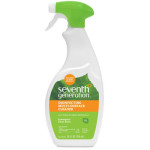
Admittedly, chlorine bleach is an extremely effective germ killer and is one of the only household cleaning materials regulated by the U.S. Environmental Protection Agency (EPA). This means that it's been proven to kill heavy-duty microorganisms, such as the E. coli. Just 1 part bleach to 4 parts water can guarantee you a urine free home. But of course there are a lot of downsides to bleach. The production process for chlorine bleach releases cancer-causing dioxin as well as brain-damaging mercury into our air and is certainly not safe for you and your family to to breathe in. It's also unsafe to store in your cabinets as high numbers of accidentally poisoned children have been reported every year from drinking the dangerous liquid. Lastly, bleach can be a little too good at it's job. It removes so much that it can strip your floors and furniture of its color.
There are products sold in stores that are specifically for pet messes. These solutions contain bacteria and enzyme digesters that effectively eliminate stains and odor without damaging or discoloring most flooring materials. Many are non-toxic and safe for your family to be exposed to.
Store bought cleaners such as the popular, non-toxic Seventh Generation cleaner are formulated to specifically kill serious bacterium such as Staphylococcus aureus, Salmonella enterica, Pseudomonas aeruginosa and Escherichia coli. Although this is great product to help prevent the spread of diseases, is this more pricey solution really necessary for your everyday pet spills?
Vinegar to the Rescue!
Vinegar can be a great, inexpensive replacement to clean up pet stains. And unlike other products, you are not paying for extra "fluff" such as thickeners, fragrances, colorants, pearlizing agents, or preservatives. As to be clear it won't be your universal answer to all types of grime, but it certainly can help with pet stains.
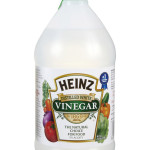
How is Vinegar Made?
Short answer: Also known as "sour wine", vinegar is a weak form of acid that forms through the fermentation of sugars or starches.
The full explanation of the process is broken down into three stages. The first stage, known as alcoholic fermentation where sugars in carby ingredients (such as grains, fruits, and vegetables) are broken down by yeast. Next a mild bacteria, called Acetobacter, is added to the mix to convert the alcohol into acetic acid, which is the main base of vinegar. Finally, the resulting acetic acid (HCH3COO) is given a variety of vitamins and minerals to further enhance the flavor.
How Does Vinegar Effectively Clean?
So why is vinegar known as a miracle clean-all cleaner? Since we now know that vinegar is acid based, it's easier to understand how it can clean so effectively. When the acid is applied to the acids in the grease, it breaks it down quickly.
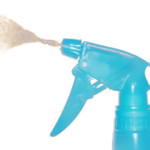
The typical vinegar that can be purchased at the grocery is actually only 5% solution (the remainder being mostly water), yet it's very effective at degreasing just about anything in your home. Vinegar can be sprayed on windows, no wax floors, and most importantly urine stains and pet odors. Remember that uric acid we talked about? When vinegar is poured onto the contaminated area, within 5-10 minutes, that stain will be broken down and essentially eliminate the urine. On top of that, vinegar's components serve as a natural germ-killer, although not as effective as bleach, will kill the most common household bacteria. Distilled white vinegar has the capability to kill 99% of surface bacteria, 80% of germs, and 82% of molds.
Vinegar Cleaning Tips
- For places where not necessarily germy/smelly but just needs routine cleaning such as windows, use half vinegar, half water
- Spray a little on pet's fur to remove undesirable scents
- Place open bowl of vinegar out overnight to absorb odor
- For more persistent stains, use a mixture of 1 teaspoon vinegar, 1 teaspoon liquid dish soap, and 1 cup warm water
- For some cats, you can spray an area with vinegar to prevent them from scratching or resting in that area
What Type of Vinegar is Best to Use?
Since vinegar can be made from anything with sugar, there are countless types made in countries throughout the world. Each country may use different materials based on what ingredients are readily available and their preference of taste.
Typical retail varieties of vinegar include white distilled, cider, wine (white and red), rice, balsamic, malt and sugar cane. There are even vinegars made from bananas, pineapples, and raspberries.
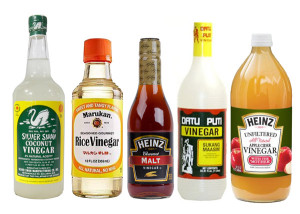
Technically any type of vinegar will have some level of cleansing properties since they all contain the acetic acid. They all also offer the unique benefit of having an unlimited shelf life. But it's the amount of acid in the solution that tells you the cleaning strength that it possesses. In the U.S., vinegar sold to the general public is regulated to have at least 4% and at the most 7% acidity (the remainder being water).
Distilled White Vinegar, one of the most common vinegars in the U.S., averages at about 5% acidity, which is many times labeled as 50-grain (every 10 grains is 1% acidity).
Apple Cider Vinegar, another common vinegar sold in the U.S., possesses about the same amount of acidity as white vinegar and therefore the same power of cleaning. Apple cider vinegar is made by fermenting apple cider. The apples provides multiple types of antioxidants that provide many beneficial effects on our health. It is more expensive than white vinegar. Although it has a pleasant odor, the scent also attracts bugs so it is not recommended to use to clean the kitchen or other areas where there may be food. Apple cider vinegar can be used to set up a great bug trap though.
Other vinegars include: Malt vinegar – also made from grains (usually barley) and originated from England. Rice and coconut vinegar is commonly used in Asia. Cane vinegar, made from fermented sugar cane, is highly produced in the Philippines. When comparing all these vinegars and all the different percentages used, distilled white vinegar seems to typically be the most acidic. If not sure, a great way to test the acidity is by how sour it is. The more sour, the higher the level of acid it contains.
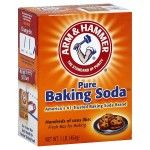
Onto the Cleaning Power of Baking Soda
Like vinegar, baking soda has also been called a miracle cure-all, not only for cleaning, but also heavily used in the medical world for hygienic purposes and valuable remedies.
What is Baking Soda?
Baking soda represents just one ingredient and is also known as Sodium Bicarbonate, a chemical compound of the mineral natron with the formula NaHCO3. It is a white, crystalline powder that can be found in several entities in nature, but the most common sources are mineral springs as well as by artificial means. It is non-toxic and completely safe to use around pets and children. While vinegar is a acidic based liquid with a sour taste , baking soda is an alkali base with a salty taste.
Baking soda is most commonly used in baking due to its rising properties. When mixed with several acids to create baking powder, the powder can be wettened and exposed to heat that causes the release of C02 bubbles and causes the mixture to rise.
Oddly enough, although it is edible and perfectly safe for humans to digest, it can also be used for killing cockroaches, removing paint, putting out electrical fires, and of course it can attack the contents in pet urine.
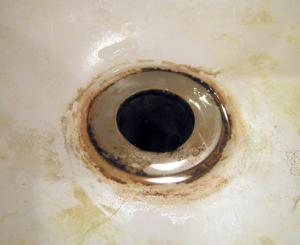 How Does Baking Soda Effectively Clean?
How Does Baking Soda Effectively Clean?
Baking soda can be just as effective as vinegar but tackles the grime in a completely different way. Instead of using acidic properties to break down the acids in the filth, baking soda uses its alkaline properties (meaning having a pH greater than 7) to neutralize the acids in the dirt by bringing both acidic and basic odor molecules into a neutral, more odor-free state.
While vinegar is mainly good for removing microbial contamination (the small bits), baking soda is better at attacking the thicker stuff. Add a little baking soda on a damp sponge to create an abrasive surface that can lift up gunk with little effort. Use it to remove sludge in your sink, clean your grout, deep-clean your oven, and remove dog and cat urine.
Need to get rid of the pet smell? Baking soda's neutralizing abilities can remove even the most unpleasant odors, and does not just cover it up like other perfumed cleaners. Intense odors either come from strong acids (like sour milk) or strong bases (like spoiled fish). Baking soda balances out those pH levels and subdues any unpleasant aromas that might have been there.
Use baking soda for strong pet odors on your carpet. Simply sprinkle baking soda in the urinated areas, let sit for at least 30 minutes and then vacuum up and the stench disappears! Does your litter box smell? That's right, sprinkle baking soda in it and notice a huge difference the next day. Like vinegar, you can leave a bowl out overnight to allow it to extinguish any smells it encounters in the air.
Please note that although baking soda is an incredible abrasive tool and an amazing deodorizer, but is ineffective against most bacteria, including salmonella, E. coli. and staphylococcus.
Let's Recap: Top Benefits of using vinegar and baking soda as a cleaner
- They're both edible and can be cooked with
- Non-toxic and Biodegradable
- Bug Deterrent
- Cheap to make and cheap to clean with
- Kills weeds but does not harm the environment
- Safe to wash down the drain and won't damage plumbing
What about Combining both vinegar and baking soda?
Some of you may be thinking, "well why not get the best of both worlds and mix the two?" Unfortunately, it doesn't quite work the way you would think. Although, mixing baking soda and vinegar is completely harmless, they end up weakening each other in the process. Since vinegar is an acid and baking soda is an alkaline base, they undergo an acid-base reaction. What this means is that the baking soda actually neutralizes the acid in the vinegar. Basically what you end up with is water and a small amount of salt.
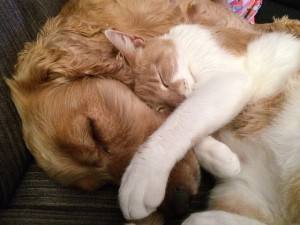 Final Recommendations
Final Recommendations
First off let us just say that vinegar and baking soda should never be your "miracle cure-all" for literally everything. Research shows that simple soap and water kills more germs than both vinegar and baking soda. However, they do both have a lot of great benefits and can help with everyday accidents and cleanups in your home, and are definitely more eco-friendly than most cleaners on the market. Keep in my that if you feel you need a higher level of decontamination, you may want to look into alternative cleaners.
Since vinegar and baking soda may not kill off serious diseases that dogs and cats are vulnerable to, it would certainly not be acceptable to use where there are high numbers of animals situated, such as locations offering: boarding, dog grooming, veterinarian care, and rescue shelters.
You can be sure that Pet Poo Skiddoo cannot fully rely on vinegar and baking soda when entering several different yards each day where dogs and cats have left their output. We strive to be eco-friendly and use both a vinegar and antibacterial soap base solution to clean litter boxes, but will always do this on site and never provide the owner with a litter box used at another home. To take special precautions, we spray down all of our tools as well as shoes after each cleanup with a strong disinfectant called Top Performance Pet 256 – a popular cleaning solution used in veterinarian offices around the country.
Related Links:
- The Clean and Green Guide -fast and non-toxic methods to clean your home.
- Fifty Uses for Vinegar
- The Five Basics of Nontoxic Cleaning
- How to Remove Cat Urine With Vinegar
- How to Clean With Baking Soda
- How Does Vinegar Work as a Cleaner?
How to Get Rid of Dog Urine Smell Using Vinegar
Source: https://petpooskiddoo.com/blog/all-youd-ever-want-to-know-about-vinegar-baking-soda-and-pet-urine/